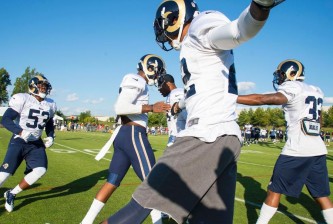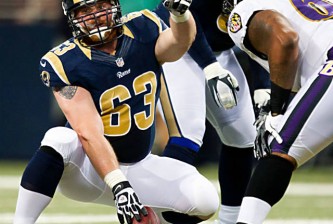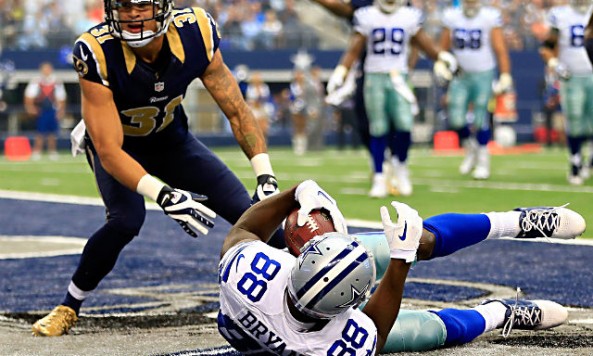We are the 71%. We are the team that turns every opposing quarterback into a Hall of Fame thrower. We are the team that you can bank on for somebody's career day each and every week, whether it's Carson Palmer, Julio Jones, or DeMarco Murray.
We. Are. Soft.
This is not the identity that St Louisans expected to take on when Jeff Fisher was hired. This is not the Jeff FIsher team that we thought we were going to get. We expected hard-nosed, punishing, in-your-face football that, yes, sometimes veer outside the lines of legal play but always – ALWAYS – ready to set a tone.
Instead, we are getting a defense that performs, in the words of Jim Thomas, "like a Steve Spagnuolo nightmare."
Actually, it's worse than that. Even when Spagnuolo's team hit bottom, in 2011, when injuries decimated our secondary and we were forced to suit up 12 different defensive backs, the Rams only gave up a 60.5% completion rate and an 87.3 passer rating against.
Fisher's team, ostensibly healthy and much more talented than Spags' collection of blue-collar grunts, is giving up a 71% completion rate and a 114.7 passer rating against. If this continues across the course of the season — and there's no reason to believe it won't since our problems are schematic rather than personnel-related in nature — these would be the worst ever given up by a Rams defense.
Worst.
Ever.
What exactly is the plan here? And the first person who says "Growing Pains" gets locked on a container ship with Alan Thicke and sent into the Pacific Gyre.
Here is the part of the article where I would provide visual evidence, but you've all seen the screenshots. Cornerbacks — not safeties — lining up in the end zone on a third and four from the nine yard line. Cornerbacks giving a ten yard cushion and running backwards at the snap on third and five. Cornerbacks and linebackers peeking into the backfield and getting burned on the simplest of play-action fakes.
I reached out to longtime Jeff Fisher observer Tom Gower, of Football Outsiders, and he is mystified as well. "Zone voids between the linebackers and safeties were the Fisher/Schwartz thing," said Gower. "I remember specific situations where the Titans should have pressed, but not it being a general problem like you're saying it is."
So what's going on here? I can think of a few theories:
"The Rams are trying to prevent big plays."
There is probably truth to this. But the downside is that the defense cannot get off the field, and give up the yards and points anyway that they would potentially be giving up with a more volatile mixture of three-and-outs and big plays.
Moreover, the current approach is limiting the offense's time with the ball, and constantly putting them in a position of playing from behind. The Rams have trailed by double digits in the fourth quarter in each of their three games. Frankly, they are lucky to not be 0-3 and staring up at the Cardinals and everyone else in the division.
"The Rams are trying to protect their young safeties."
This theory was blown out of the water by Coach Rick Venturi in a segment on 101 ESPN. He saw, as we did, the Rams play soft all last year with veteran safeties. He is as mystified as any of us. And if anything, systematically jamming receivers at the line rather than give them free release would seem to help the safeties keep the play in front of them.
"The Rams are losing faith in Jenkins and Finnegan."
This, frankly, is a possibility. Finnegan is becoming an old man, and neither he or Jenkins have the strength to knock the NFL's bigger class of receiver off of his route. Still, though, Jenkins' talents are in running with the receiver. When he is allowed to play close, he makes plays. When he is forced into a soft zone, he often looks lost. Likewise, Finnegan made hay by lining up in the slot and being a disrupter. If he is losing a step, moving him several steps back isn't helping.
"Tim Walton is overmatched and is not ready for prime time."
There may be a strong argument to make here, and Bernie Miklasz for one is not afraid to make it.
I thought Tim Walton was a good hire by Fisher. May rank among by bottom 10 dumbest opinions, ever.
— Bernie Miklasz (@miklasz) September 22, 2013
But one would think that his inexperience as a defensive coordinator would be buoyed by the amount of support from the rest of this very experienced defensive staff. Rather, it appears that the veteran staff's rigidly defined defensive identity is putting Walton in a position where he cannot succeed. Prior to being hired by the Rams, Walton had been given play-calling duties for the Lions on third down. The Lions gave up only a 36% conversion rate on third down, a top ten rate across the league. The Rams are currently giving up conversions on 50% of third downs, the worst rate in the league.
"The Rams should have signed Rob Ryan after all."
Three games in, you could certainly make that case. The Saints look completely reenergized on defense, despite lagging behind the Rams — significantly — on talent. There are no Chris Longs or Robert Quinns on Ryan's defensive front. Curtis Lofton for James Laurinaitis is essentially a wash. Kenny Vaccaro and TJ McDonald are booth rookies being given full-time jobs.
But the Saints are playing aggressively on defense, and the Rams are not. And the passive approach is visibly eating away at this team's confidence. They looked tired in Dallas. They looked frustrated and fed up. This is week three.
The silver lining here is that there is still time for a wake-up call. There is still healthy talent to work with. But the "Growing Pains" excuses have to stop. The softness has to stop. Jeff Fisher's defense needs to re-establish its identity, or it will go down as one of the most disappointing units in Rams history.























